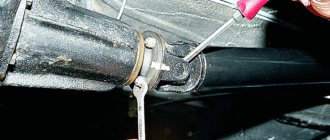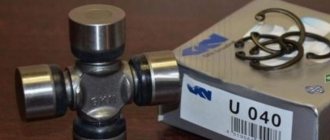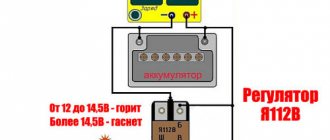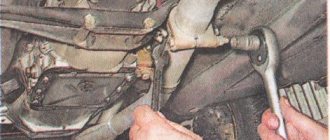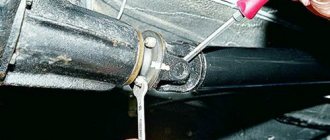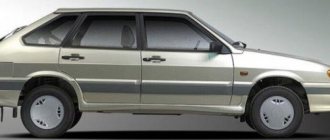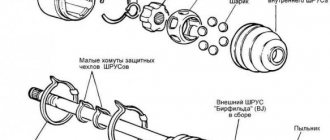From trucks and SUVs to compact cars and sedans, your vehicle's powertrain system helps keep you on the road.
Also called the driveshaft, the transmission is responsible for shifting your vehicle from idling to driving. A bad or faulty driveshaft can make your vehicle difficult to control. And the main cause of breakdowns is the lack of lubricating mixture in its connections.
How to inject cardan crosspieces? Just something complicated
Quite often, drivers wonder how to inject cardan crosspieces.
This is one of the common questions that beginners ask, but this work needs to be done quite often. At the same time, injecting is not a complicated action; it can be done in any garage, but you will need a tool. And despite the ease of repair, many people are simply afraid to touch the driveshaft themselves; for some reason it is believed that any work with the transmission requires high qualifications. This approach is justified if it is necessary to overhaul the automatic transmission, but the lubrication of the crosspieces can be done independently. How to inject cardan crosspieces is a simple question. To do this, there are a number of devices that make the task easier. It is much more difficult to correctly determine the time when this needs to be done. Here the task is complicated by the need to determine whether the crosspiece needs to be replaced completely, or whether it is enough to simply lubricate it. Below we will look at all these points.
Design features
The driveshaft consists of 2 elements (in some types of equipment there are 3 elements), this allows you to transfer force from the gearbox to the axle with minimal losses. The elements are connected to each other by a cross. This hinge connection allows for optimally secure fastening between the nodes. At the same time, minimal wear of the associated elements is ensured.
The crosspiece requires constant lubrication
, so it is tightly stuffed with a plastic substance at the factory. This allows you to avoid problems during operation. But, unfortunately, there is not enough lubricant for the entire service life, so it must be added.
For process continuity, manufacturers have provided the ability to supply lubricant directly inside the crosspiece, without dismantling the cardan. This makes operational work easier. Also, thanks to this, it is possible to quickly perform injection if necessary.
If you do not lubricate the part, it will fail much faster. It is also worth considering that the crosspiece is almost constantly exposed to sand, dirt and reagents. Therefore, only the proper amount of lubrication can avoid many problems with this structural element.
When is work required?
It is important to correctly determine when to add lubricant, this will significantly increase the life of the spider. According to the manufacturers' recommendations, this element should be lubricated about once every 10-15 thousand kilometers; more precisely, you need to look at the list of scheduled maintenance work.
But it is not always the case that crosspieces can be used freely for the entire time allotted for this by the manufacturer without lubrication. The reasons for this are very different, most often due to rather harsh operating conditions. Often, SUVs that are operated in harsh conditions require increased attention to the driveshaft. This is due to constant contamination of the joint, which leads to the production of lubricant at an accelerated rate.
In any of the above cases, it is simply necessary to eliminate the problem as soon as possible.
List of main faults
Typically, the crosspiece in the cardan transmission lasts a long time, and its service life is calculated at approximately 500 thousand km. However, in reality, everything is not so and after 50-100 thousand km the crosspiece already needs to be replaced. Moreover, this is influenced by a number of factors:
- terms of Use;
- manufacturer;
- quality of materials used.
Frequent travel around the countryside also makes its contribution. Dirt and bumps - all this significantly reduces the already short period of operation of the hinge. Here, lubricant alone for the cardan shaft crosspieces will not be enough.
The list of the most common crosspiece malfunctions includes ordinary inattention during a scheduled inspection. In some cases, the lack of lubrication is not given due importance. And subsequently the cross will make itself known accordingly.
Other common malfunctions include the following cases:
- a noticeable play of the cross appears;
- the needle bearing wears out;
- wear occurs on the crosspiece itself;
- leaked lubricant or its complete absence;
- destruction of sealing rings;
- while the car is moving, you can hear a metallic ringing;
- A cracking sound is heard in the area of the cardan joint.
No matter how reliable the crosspiece is, sooner or later it will fail. In this regard, the best option for preventing this part is to inspect it every 10-15 thousand kilometers. It also doesn’t hurt to make sure there is lubricant for the crosspieces.
And for those car enthusiasts, in particular, who own jeeps and like to take mud baths, it is worth checking the condition of the cardan drive after each such trip.
Necessary tool
So, you have established that it is necessary to lubricate the cardan cross once again. It is worth considering that this work cannot be done without a special tool, so you will have to prepare for the process in advance.
First of all, purchase a special syringe for lubricating cardan shafts; it is inexpensive and will last quite a long time. For this work, a lever-plunger type syringe is used. Please note that different models have different holes for lubricant supply, oil seals or nipples may be used, so check this nuance and purchase the appropriate nozzle.
Another point is the choice of lubricant
. Here it is worth familiarizing yourself with the manufacturer's recommendations. In many cases, modern cars use a specialized lubricant that is designed for a specific brand. The result of mixing it with other types of lubricant is quite difficult to predict. Therefore, if the manufacturer accurately indicated a specific brand of grease, it is better to use that particular one. If there are no clarifications on this matter, then you can use any option designed for such an application.
Blue remedy number 158
During Soviet times, blue grease for crosspieces “158” based on a lithium-potassium complex was in great demand. Currently, lubricants using a lithium thickener have begun to be produced. This made it possible to significantly increase the upper operating temperature range, which is now +165°C or more.
A characteristic distinctive feature, as can be understood, is the shade of the lubricant numbered 158. However, this does not say anything specifically about the properties. For a number of manufacturers, this step is justified in order to identify products and give them an attractive presentation.
In European countries, pigments are used for this, which color the lubricant not blue, but green or red. The color design may also vary if, for example, the same lubricant for Liqui Moly universal joints is ordered by different suppliers.
How to inject?
Let's look at the process of doing this work. It is worth noting that on almost all models it is completely the same, there are only minor differences. So, lubrication is carried out in the following order:
- Drive the car onto the overpass. Wheel chocks are placed under the wheels;
- Clean the cross. To do this, first wipe it with a rag, then wash it with diesel fuel or carburetor cleaner;
- Prepare the syringe for use by pumping the required amount of lubricant into it;
- They open access to the slots of the crosspiece, and use a syringe to pump the part with lubricant through an oiler. Be sure to open the oiler on both sides; pump until new lubricant comes out from the other side; it will be noticeably different in color.
At this point the work can be considered completed.
conclusions
. As you can see, there is nothing complicated here. To answer the question of how to inject cardan crosspieces, it is enough to know the technical features of this car unit. In general, neither the selection of tools nor the work process itself should cause any difficulties. It is worth considering that the service life of the crosspieces and cardan directly depends on the quality of the lubricant. Therefore, do not neglect this work.
KIA Sportage Grand › Logbook › A tale about injection of universal joints - do it yourself
I really want to tell you (once again to cry about what kind of comrades work in the service) about how I myself went the way of injecting universal joints)))))
In short, the story is this:
for the entire time that I have been the owner, among all the other work that was done at the service, I asked 4 times to have the cardans injected
did, as it turned out, never...
As it turned out, I read the forum, drive and in several places I came across similar opinions that injection is better done with an internal combustion engine oil change (7-9 thousand depending on the load), and I just changed the oil.
I think I won’t go to the service center for injection anymore, since I changed the oil, I’ll go and do the injection myself, because earlier in one service center the master checked everything and did not consider it necessary to do the injection (but they didn’t take the money then), in another they didn’t they were able to, because they didn’t have a syringe (!), the third SC did something, but the lubricant scattered all over the bottom, at first I didn’t understand why this was so, but after I did everything myself, now I know that they didn’t do a damn thing then They did it, but they took the money.
here I won’t continue to push for manhandling again (apparently, for some reading this it’s like a sickle on the fingers) just the text:
So, to carry out high-quality (in my opinion) injection you will need:
1. buy lubricant for crosspieces: LIQUI MOLY — Mehrzweckfett
2. buy lubricant for splines: YES - YES! (again according to Galygin) - it turns out that when injecting, 2 different lubricants are used! so fucking different that they are EVEN DIFFERENT COLOR!
LIQUI MOLY — CV joint grease with molybdenum disulfide LM 47 Langzeitfett + MoS2 400 ml
3. I bought 2 plunger syringes to insert these tubes into; the kit included flexible hoses for ease of fitting into the grease fittings of the crosspieces.
then, on occasion, there was a visit to the service center, where, while the machine was hanging, I asked for free, out of great friendship, to show how to insert the tube into a syringe and how to syringe. Please don’t laugh here - it’s better to see it once...
so what did I see? how to insert and pump grease into a flexible hose is half the job (for which special thanks), then the following happens - since it’s a little dark under the car, the technician found the oiler by touch in the rear crosspiece of the rear universal joint, easily tucked the head of the hose onto the oiler, pumped it a couple of times, Fresh grease immediately came out (from the oiler side). That's it, he says, see if the lubrication has gone?
I think to myself, what’s wrong - the fresh lubricant should squeeze out the previous lubricant through the rings, which should even be of a different type - worn out.
Because they didn’t take any money for it, I went home from them, and the next morning I had an early start to Belarus. I took the syringes with me - I think I’ll figure it out at my leisure.
there he crawled under the car and started looking.
Firstly, there were rubber caps on the oil nipples! and judging by the lubricant that fanned out, it did not go inside the cross, but came out under pressure from the syringe fitting in front of the cap:
Such caps appeared on all crosspieces.
however, on the oiler, which is splined - there was no cap - apparently lost:
so, first we put the syringe fitting on the oilers without caps))))), pump it, we see that the black slurry is squeezed out from under the rings (though not from under all of them) between the cross and the cardan (more precisely, the U-shaped part of the cardan - I don’t know how it's called), just as a lot of clean lubricant falls to the ground, as it gags famously past the oiler - apparently, a low-quality syringe (300 rubles) or incompatibility of the fitting and the oiler ((((
there were no problems with the rear driveshaft - it’s a pity that a lot of grease gets squeezed past ((everything excess that didn’t get into the crosspiece, but densely filled the space between the joints around it - we wipe it with a rag or, like me, with toilet paper that was at hand))
Next, we take off the protection and plastic boots, and similarly inject the front driveshaft. I still have the Belkardovsky one. last year it was disassembled and cleaned, I skated for a year without problems - when necessary, the PP was connected and there were no questions about the operation of the cardan.
However, not all so simple. The fitting turned out to be a bit thick in diameter and did not want to get close to the oiler. I accidentally turned the oiler with my finger - for some reason it easily spun inside the crosspiece and it was difficult to fit the fitting onto it. pumped it up, the song repeated itself - a little black slurry came out, and not from all the rings, a kilogram of good lubricant was gone.
Then the dancing with the tambourine began - the syringe fitting did not want to come off the oiler.
I pulled and twisted the cardan shaft, and the oiler with a hose, and took out a screwdriver - so that, like a lever, sliding it under the fitting, I could squeeze it out of the oiler... in short - the word is fucked - the easiest thing)))))
In general, almost tearing off the hose, he pulled it off. ... cursed everything! (maybe that’s why no one injected the cardan?)
Because stopping there is not my topic - there was a similar pandemonium with the second cross. except that I quickly used a screwdriver to pry off the fitting when I took it out
I also decided to remove the rubber corrugation from the slot and see what happened there over the year:
sad, but not a disaster
marked the joints, took off the cardan (the nuts came off easily), cleaned everything, changed the tubes in the syringe, pumped it so that the previous lubricant came out and pushed it heartily into the spline
assembled, installed, checked that there was some play (the plastic connection was knocked out last time), drove on asphalt with PP - beating and vibration appeared after 80 km/h, assembled the protection and finally, since there was already spline lubrication in the syringe, pumped the lubricants into splined rear cardan.
Injection of the cardan shaft crosspiece
Grouting the driveshaft spider is a fairly simple job that must be performed regularly to maintain the transmission in working condition. However, many drivers decide to seek such work at a service station, when it is quite possible to do it themselves. The main thing that is required to perform this kind of work is to have the necessary tools and choose the right way to inject the cardan crosspieces with it. In this article we will consider this issue.
What is a cardan shaft
The job of the driveshaft is to transfer force from the vehicle's gearbox to the axle. Most often it consists of two or three elements interconnected by a cross. The crosspiece is a hinge joint that provides reliable fastening between units with minimal wear during operation of the mating elements.
In order for the crosspiece to fully cope with its functions and not lose efficiency, it needs constant lubrication. When the car leaves the factory, the crosspiece is tightly packed with lubricant, which should be enough for a long time of operation of the mechanism, but at a certain time it runs out and needs to be replenished.
The device of the cardan transmission and its role
The main task of the driveshaft is to transmit torque from the engine to the wheels. It provides the connection between the gearbox output shaft and the drive shaft of the rear or front axle. This is in cases with rear or front wheel drive. In all-wheel drive models, the front and rear axle shafts are connected to the transfer case shafts.
The main unit of this connection is the hinge, which in turn contains an equally important part - the cross. And as you can understand from the name, it is made in the form of a cross. At each end there is a cup with a needle bearing, which is separated from the housing by a rubber or plastic o-ring. In the absence of lubrication for universal joints and bearings, they quickly fail. The size of the crosspiece is different for each car.
When to inject a universal joint on a driveshaft
The list of scheduled vehicle maintenance work should indicate the frequency of injection of the driveshaft crosspiece as recommended by the vehicle manufacturer. On average, the lubricant component must be updated every 10-15 thousand kilometers of the vehicle.
Important: When operating a vehicle in difficult conditions, the service life of 10-15 thousand kilometers is significantly reduced. For example, if we are talking about constant off-road driving, you need to take care of lubricating the crosspiece much more often.
There are several symptoms that indicate that the driveshaft crosspiece needs to be injected:
- When the car moves from a standstill, a noise similar to crunching or tapping is heard in the area of the driveshaft;
- At high speeds (above 60 kilometers per hour), the vibration of the car and the “shaking” of the cardan are clearly noticeable.
If the above symptoms are observed on the car, you need to inject the driveshaft crosspiece as soon as possible.
Diagnostics
Carrying out any repairs is impossible without first diagnosing the vehicle. And since the crosspiece is the central link in the cardan transmission, it is worth taking a more responsible approach to its inspection.
Typically the problem appears:
- noise;
- whistling;
- hum;
- strong vibration;
- clicks;
- metallic grinding or crunching sound.
This can especially be felt when starting off, or while the car is moving, or when changing gears. In some cases, the malfunction may be hidden, so it is extremely important to detect the breakdown in a timely manner.
Currently, in many car services, diagnostics of car parts, including the chassis, are carried out using modern equipment. This allows you to quickly and with maximum accuracy detect a breakdown and determine whether there is lubricant for the crosspieces or not at all. Depending on this, one or another method of liquidation is selected.
How to inject the cardan shaft crosspiece
To carry out the work of injecting the cardan crosspiece, you will need to purchase a special tool - a syringe for lubricating cardan shafts. It can be purchased at almost any specialized automotive store. Such a syringe has a lever-plunger design and can last for many years.
Please note: Depending on the car model, the technological hole through which the lubricant is “poured” differs. Before purchasing a syringe, you need to determine whether seals or nipples are used, since you will need the appropriate nozzle.
You need to choose the lubricant that will be used for injection based on the recommendations of the car manufacturer. Most often, a lubricant specialized for a specific car model is used, and it is better to purchase it. If you pump a lubricant into the crosspiece that is different from what is already present there, there is a high risk of their “incompatibility,” which can lead to various kinds of problems.
Please note: If the vehicle's technical operating instructions do not indicate which specific lubricant to use for injecting the driveshaft crosspiece, this means that any universal grease will do.
What lubricant should I use for crosspieces?
Since the crosspiece of a car is one of the key parts that need lubrication, you should not skimp on materials. It is necessary to select compounds that have high performance characteristics and are able to cope with the high loads to which this part is subjected.
Mandatory lubrication requirements for propeller shaft crosspieces are:
- 1. Water resistance.
It is possible that moisture can get inside, and the lubricant must adhere well to the part so as not to wash out. - 2. Corrosion protection
. Lubricant protects parts from rust. - 3. Operability in a wide temperature range
. The equipment is used both in winter and summer. In addition, the driveshaft itself is subject to high pressure. The lubricant must withstand difficult operating conditions. - 4. Good adhesion to the surface
. You cannot pour oil into the cardan: it will drain from the parts, as a result they will be subject to scuffing and quickly fail. The lubricant for crosspieces must be gel-like and have high colloidal stability, so that even after softening it can restore the structural frame again. - 5. Chemical stability
. The lubricant must not react with alkalis, acids, solvents and other chemicals. - 6. Compatibility with other lubricants
. If before or after lubrication of the crosspiece other compounds were placed in the transmission units, then the universal joint lubricant must be compatible with them.
Lubricant for crosspieces of UAZ and cars of other brands must be operable in the temperature range from -50 to +100 ° C, be water resistant, and have anti-corrosion and extreme pressure additives. "MSK" offers to buy products that are ideal in all respects.
How to inject a universal joint on a cardan shaft
To carry out the work of injecting the driveshaft crosspiece, you will need to drive the car onto an overpass and install wheel chocks under the wheels. Next, follow these steps:
- Remove dirt from the crosspiece. It is recommended to use carburetor cleaner, special cleaning compounds, or simply white spirit for this;
- Next, pump the purchased lubricant into the syringe;
- Open access to the slots of the crosspiece and, using the prepared syringe with grease, pour grease into the part through the “oiler”.
Important: When pumping lubricant, open the oil can on both sides. It is necessary to pump in lubricant from one side until grease begins to come out from the other side, then we can assume that it is completely filled with lubricant. Please note that the grease coming out from the other side will be different in color.
After completing the steps described above, you can consider the work completed.
Consequences of ignoring a fault
Ignoring the lubrication of crosspieces can lead to the most disastrous consequences, including complete failure of the spare part and breakdown of your car. In this case, you risk not only your life, but also the lives of passengers.
If you do not carry out the procedure, you risk facing the following consequences:
- Vehicle vibrations. Worn seals or bushings can cause the driveshaft to vibrate. Failure to properly lubricate spiders, joints, or bushings can cause further damage to other transmission components. Note that tire problems can also cause vibration problems, but they are easy to tell apart. Vibrations caused by tire balance problems are speed sensitive, but driveshaft vibrations are not.
- Difficulty when turning. If you are having trouble turning, it may be due to a problem with the driveshaft. A faulty driveshaft can prevent your wheels from turning correctly, making your vehicle difficult to control.
- Loud noise. If you hear a loud noise when your car shifts gears, this is another sign of driveshaft damage. The likely culprit is worn crosspieces.
- The car shudders when accelerating. If you experience a shudder when accelerating from a stop or at low speeds, a loose weld or a bad center bearing may be to blame.
- Creaking noise. An annoying squeaking sound at low speeds can be caused by a lack of lubrication on the spiders. The lubrication procedure will get rid of it.
- Clicking or knocking sound. May indicate a worn or faulty driveshaft. Contact your mechanic.
As you can see, in order to ensure long-term and stable operation of your car, in addition to standard maintenance, you must carefully monitor the lubrication of the cardan crosspieces. If you have already encountered the procedure, tell us about it in the comments below the article.
Technical issues of various series
Those. Landcruiser series 40, 55, 60 questions
Classic axle spring Landcruiser 4x, 55 and 6x series
Those. questions Landcruiser "light" 7x (2L, 2L-T(E), 3L, 1KZ-T(E) and 22R(E))
Easy 70s and everything about them
Those. questions Landcruiser "heavy" 7x (1HZ, 1PZ, 3B, 1FZ-FE)
Expeditionary Classics (75-79 Pickup)
Those. questions Landcruiser 80, 100, 105 series (Lexus LX 450, 470)
Questions about full-size and axle SUVs
Those. Landcruiser 200 (Lexus LX 570), Sequoia, Tacoma, Tundra questions
Modern Toyota developments in the field of large SUVs and pickups
Those. 4Runner and HiLux 1st and 2nd generation questions
SUVs and pickups of the 6x and 130 series
Those. questions 4Runner and HiLux 3rd generation, Landсruiser Prado 9x
Cars series 185 and Prado series 9x
Those. 4Runner and HiLux 4th and 5th generation questions; Landсruiser Prado 12x,150 (Lexus GX); FJ Cruiser
Platform machines 215 and 285
Those. questions Highlander (Lexus RX), RAV4 and other Toyota cars
Discussion of all four-wheel drive Toyotas
General technical questions
Issues of operation and maintenance of automatic transmissions on Toyotas and not only. Because the boxes of many models overlap
Tuning, styling, interior, car audio and theft protection
“Non-power” body kit, trim and restoration of the interior, car audio, sound insulation, anti-theft, etc. for all models of Toyota SUVs.
Other related Toyota issues.
Life of Toyota 4x4 - problems and solutions are common to all platforms.
Technical non-Toyota questions
Any car from Acur to UAZ, if it has a steering wheel, wheels and it’s not a Toyota
Common topics
Meetings, rides and events of the Land-Cruiser.ru club
Trips, meetings, events, competitions organized by the site Land-Cruiser.ru
Events of other clubs
Announcements about events of other clubs
Congratulations, funny jokes and other offtopic
Auto tourism
Trips. Cards. Tracks reports.
We sell, buy, exchange.
Car sale
Please place advertisements for car sales here
Store Market.land-cruiser.ru
General questions about store operations and product discussions
General questions about store operations and product discussions
RAF Trophy Raid Committee
News, announcements and communication with representatives of the RAF Trophy Raid Committee
Technical and organizational issues
Everything related to specific competitions: where they are held, who is going, what helmet to buy, how to connect the trip, etc.
Flea market (motorsport)
Purchase and sale of auto sports equipment
How and why to syringe the driveshaft crosspieces? blog and news
Let's start today's conversation with a brief excursion into technical literacy.
What is a spider and why a driveshaft?
Every driver generally understands that a driveshaft is a kind of tool that transmits force from the transfer case to the gearbox, and then to the wheels of the car.
For the first time, this principle of energy transfer was described by the Italian mathematician J. Cardano, in whose honor it was later named, was first used in mechanical engineering at the end of the 19th century by Louis Renault and has remained an indispensable element for all-wheel drive and rear-wheel drive cars for more than a century.
The driveshaft consists of a tube-shaped shaft with forks at the ends and two crosspieces.
The crosspiece is a part of the driveshaft that allows for flexible connection of the transfer case and vehicle axles.
The crosspiece is located between two rigidly fixed forks of the propeller shaft and is driven by a system of needle bearings located at the four ends of the crosspiece.
(I’m thinking of inserting a gif with a gimbal from the Internet. It’s hard for the user to perceive in my opinion)
Cross bearings, an element that is in constant extreme conditions. Water, sand, dirt wash out the lubricant, which in the absence of maintenance leads to failure of the crosspiece.
The photo shows that all the needles have fallen out of the bearing and instead of lubricant there is only dirt and ground metal.
How to recognize the imminent “death” of a crosspiece?
1. Starting from a standstill will be accompanied by a characteristic impact with a metallic sound 2. The car will begin to vibrate at speed 3. Before completely falling apart, a characteristic crunch of ground iron will be heard
However, the death of crosspieces can be prevented and their replacement can be delayed indefinitely.
To do this, it is necessary to carry out periodic technical inspection of the transmission, inject the crosspieces at approximately the same time as changing the engine oil, i.e. every five to six thousand kilometers.
Today we will tell you in detail how to carry out injecting yourself, and not give money to services for a service that they can ultimately “provide” to you.
— For highly loaded components and assemblies. — Effective universal grease for automotive, industrial and agricultural work. — Has excellent water-repellent and anti-corrosion properties. Suitable for use on boats, ships and yachts. — Ideal for lubricating bearings, ball joints, water pumps, steering rods, suspension parts, moving and sliding mechanisms operating in difficult conditions and outdoors.
Used for cleaning the surface of engines, spare parts, and industrial equipment. Effectively removes oily stains, bitumen, resin and other contaminants.
3. Grease syringe. Lever-plunger
All injection work can be easily done without removing the units, on any lift or pit. In our case, it was necessary to simultaneously change one of the crosspieces, so the operation is carried out on the removed cardan shaft.
As we said above, crosspieces are in an extremely aggressive environment, so they often look like in the photo. Before starting work, clean the surface with carburetor cleaner, you can also use a professional engine cleaner
For injection we will need a grease syringe - lever plunger or pneumatic, it all depends on the budget, as well as a lithium grease cartridge.
After unscrewing the cap, remove the plastic cap from the cartridge and load it inside the syringe.
After charging, open the top iron cover and screw it back on.
Connect the syringe to the grease nipple and pump. The guarantee that you are doing everything correctly will be the old grease that begins to come out of the cross.
We squeeze out all the old grease from the crosspiece bearings, along with dirt and wear, until red grease comes out.
Now the driveshaft can be installed in place!
Injection of other transmission elements.
Do not forget that in addition to crosspieces, there are other parts that need to be serviced. 1. Splined cardan shaft. On the shaft pipe you can see a grease nipple; it serves to lubricate the spline connection of the two parts of the cardan. It should be injected together with the crosspieces.
Steering tips. Good manufacturers of spare parts always have grease fittings on the steering ends. Periodic lubrication of balls will extend their service for many years.
Steering linkage. By analogy with the tip, it requires lubrication.
That's all! Take care of the condition of your car and it will never get old :)
Successful advertising
Thanks to the efforts of many marketers, blue grease is now a sign of versatility and high quality. For the first time, a blue-colored lubricant was produced by ExxonMobil and Chevron in the West. The product unexpectedly showed its best performance under normal operating conditions of almost any equipment.
Now blue lubricants are already a standard of quality. They are especially popular in the Russian Federation. They are widely used in servicing not only various types of transport (automobile, railway, water, tractor, special equipment), but also various industrial equipment. And the question of what lubricant to inject the crosspieces with is resolved on its own.
The absence of lubricant in at least one of the propeller shaft bearings or if traces of rust, water or dirt appear in the lubricant indicate the need to inspect and repair the shaft in a specialized workshop. To avoid possible malfunctions of cardan shafts associated with insufficient lubrication of its elements, it is necessary to correctly and promptly inject all lubricating points of the shaft. The shaft should be lubricated with a grease nipple until the safety valve in the joint is activated or until grease appears from under the seals.
For high-quality maintenance of cardan shafts, you cannot do without a syringe and FIOL-2U lubricant. Shafts that are used in harsh conditions, often in contact with water and dirt, have a special need for extrusion. The rear crosspiece of the rear propeller shaft is especially susceptible to the influence of these aggressive environments, since it is closest to the road surface. Many motorists do not pay enough attention to lubricating the driveshaft, mistakenly believing that it is enough to lubricate it once a year without removing it from the car.
Lubrication of the driveshaft cross has its own characteristics. The main thing is that maximum lubrication efficiency is achieved only when removing the part or using an adapted syringe, since the cross is located in a hard-to-reach place. A regular syringe can also be used, but requires an adapter. But using an adapter is not recommended, since due to the limited visibility and the presence of a connection between the syringe and the adapter, lubricant may leak out in the wrong place, creating the illusion that everything was done correctly. Lubrication must be carried out until the lubricant is in all oil seals.
When using an adapter, a large amount of lubricant does not enter the crosspiece. Motorists don’t always bother going for additional FIOL, so they either use the lubricant that fell on the floor or simply leave everything as is. It must be remembered that it is almost impossible to assess the condition of the cross without removing it. This is an additional factor in favor of the fact that the crosspiece should be lubricated when it is removed, since it becomes possible not only to lubricate, but also to evaluate the condition of the crosspiece.
All cardan shafts have three injection points. First of all, this is an oiler, which is located near the spline joint. The remaining two points are two grease fittings on the crosspieces.
How to lubricate the driveshaft? First you need to remove it and clean the grease fittings from dirt. Then you can start lubricating, keeping in mind that excessive force is not the best solution here. It is necessary to ensure uniform penetration of lubricant into all parts of the mechanism, and strong pressure can lead to the fact that the lubricant will go only one way. After lubrication, it is necessary to place the shaft vertically and lightly press on it so that excess grease comes out of the spline joint. If this is not done, then reinstalling the cardan on the car will be difficult due to excess lubricant pressure.
When using a car, Niva Chevrolet, many people forget that the driveshaft crosspiece needs to be lubricated, and this must be done according to the regulations every 15,000 km. And if the car is often used in an environment such as puddles, sand, etc., then it is advisable to inject them more often. Most car owners do this without removing it from the car, so the crosspiece is not lubricated well enough, and to do it correctly, it is advisable to remove it. For standard syringes, the oil nipple is in an inconvenient place, and operation may require a special adapter that is not stable enough. During injection using an adapter, grease for the driveshaft crosspieces may begin to leak from the joints, and if it flows at the junction of the grease nipple with the adapter, it may create the illusion that the injection of the crosspiece was done properly. To lubricate as needed, you should syringe until lubricating fluid flows through all the seals of the cross. Therefore, to be sure that the injection was carried out efficiently, the cardan must be removed.
The cardan has several points that need to be lubricated, these are:
- A pair of grease nipples, they are located on the crosspiece
- One oiler located near the spline joint, so you can lubricate it without removing it
There are different types, for example, you can use mobil xhp 222, below is the table and use it to decide what to choose.
